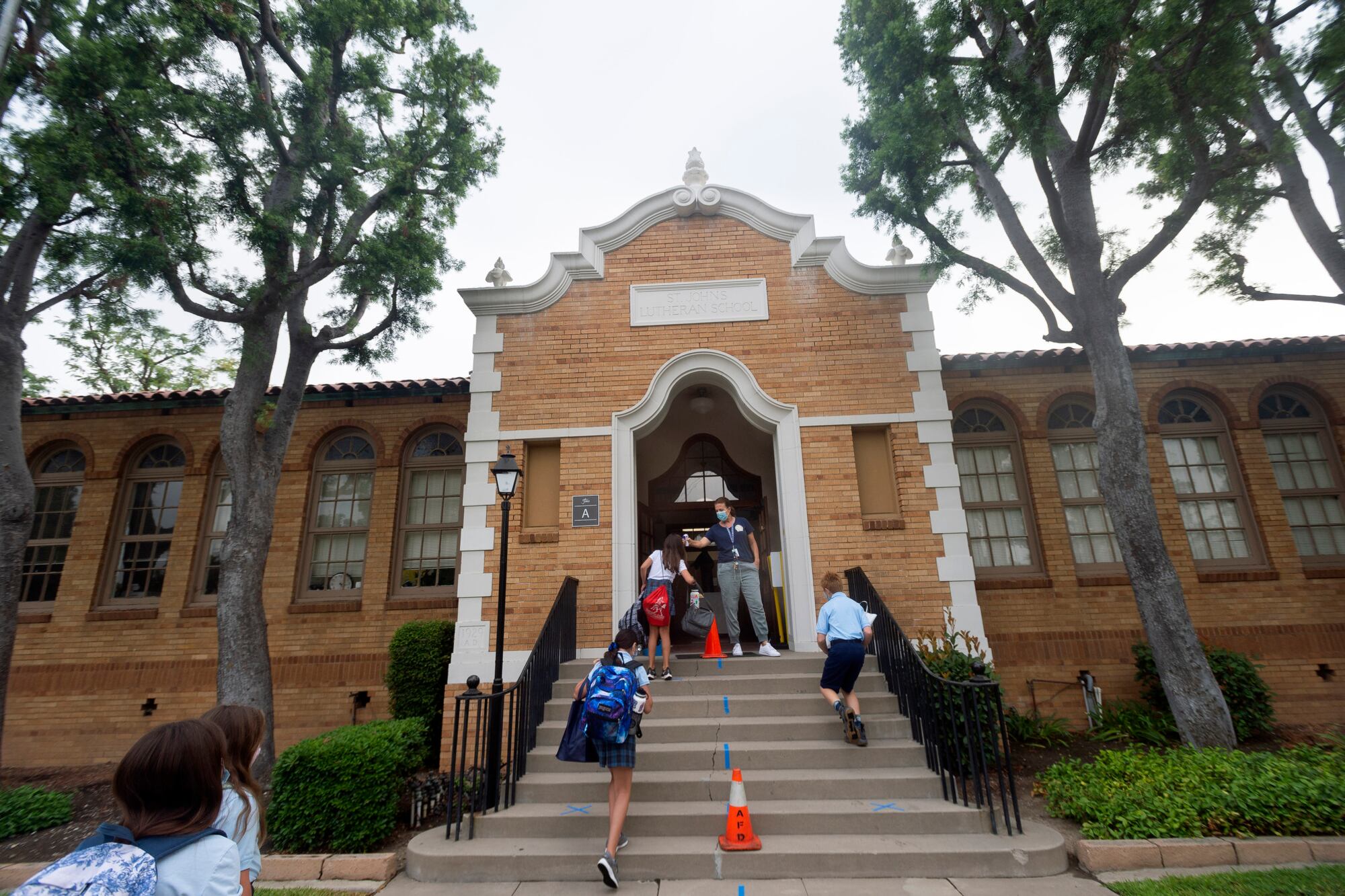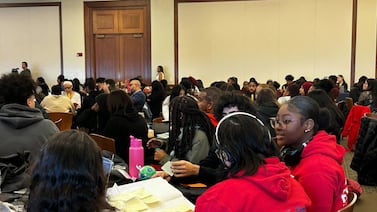In three decades of working on school district finances, Judith Marte has never had a more challenging year.
“This has been by far the most difficult year to plan because of the level of unpredictability,” said Marte, the chief financial officer for Broward County schools in Florida.
But she got a welcome bit of news this week: the state of Florida will largely spare school districts from funding cuts this year, despite enrollment declines and a state budget shortfall. Broward, the country’s sixth-largest district, has also benefited from over $40 million from the federal CARES Act. The federal money has covered the cost of masks, additional cleaning services, and technology made necessary by the pandemic so far.
National data on school funding right now is scarce, and the specific financial positions of states and schools vary. But most states have not yet cut education budgets, and many have brought in more tax revenue than expected. That’s a win for schools that were bracing for a big, immediate financial hit.
The longer-term picture remains concerning, though, as states are still facing budget problems, the prospects of more federal relief are uncertain, and students’ academic needs are continuing to grow.
That leaves Marte where many of her colleagues across the country are: in a better-than-feared financial position, while still quite nervous about the years ahead, including whether the district will be able to offer extra help to students who have fallen behind.
“The biggest financial concern we have is where the money comes from next year,” she said. “We definitely are at the mercy of the state and the federal government.”
The short term: state revenue is better than expected, CARES has helped
After the pandemic closed virtually every American school this March, districts began spending money — particularly on the laptops, tablets, and hotspots students needed to learn remotely. But school districts also saved money on electricity costs for schools that weren’t open, fuel for buses that weren’t driven, and substitute teachers who weren’t used. Some districts quickly furloughed some staff, saving more.
Nolberto Delgadillo, the CFO of Tulsa Public Schools in Oklahoma, says the district saved about 1% of its budget this spring thanks to the building closures. “I’ve had this conversation with some of my peers across the country — we were on the lower end,” he said.
It’s not clear how much money was saved nationally, and it was almost certainly fairly modest, though small amounts can be significant in tight times. One analysis of four districts found they saved about 1 or 2% of their annual budgets this spring. Districts that have remained remote this fall or furloughed more staff may have continued saving money.
In late March, Congress also passed the CARES Act, which earmarked over $13 billion for schools (about $250 per public school student) and provided an additional $3 billion for governors to divvy up between K-12 and higher education.
Many feared that this would be woefully insufficient, since the pandemic-fueled recession stood to decimate state sales and income taxes — revenue that is the lifeblood of public schools, particularly in high-poverty areas. The Center on Budget and Policy Priorities, a progressive think tank, projected in May that states would lose out on $185 billion in tax revenue by summer, a figure portending deep cuts to education.
Some states, like Ohio, quickly made mid-school year cuts. Colorado cut state funding for schools this year by 5% across the board. California delayed payments to schools, forcing them to borrow. Other states, like New York and Texas, took new federal money earmarked for school districts and simply cut state funding to schools by the exact same amount.
Nationally, these huge budget holes didn’t appear, though.
In October, the Center on Budget and Policy Priorities calculated states were actually just 2% or $22 billion short, far less than its earlier estimate. In California, for instance, revenue saw a “dramatic rebound,” according to state analysts. Colorado has seen higher-than-expected revenue, too.
“We actually have seen, in the last couple of months, much better news at the state level,” said Michael Griffith, a fiscal policy analyst at the Learning Policy Institute, a progressive education think tank.
That reflects a quicker-than-expected economic bounceback and the apparent success of the federal CARES Act, which included provisions — increased unemployment benefits, $1,200 checks — that kept families from deeply cutting their spending.
Ultimately, most states have not made education cuts this year, according to data compiled by Rebecca Sibilia, who previously led the school funding group EdBuild.
Still, some schools are facing financial stress. In states that cancelled out CARES dollars with cuts, districts don’t have that extra cushion. Other districts have made costly decisions to improve ventilation or hire more teachers to help balance remote and in-person instruction. And more places might have made similar investments if they had the money to do so.
Tulsa, which only briefly reopened buildings this year, illustrates the forces pushing and pulling district budgets.
The district has saved money from building closures, but spent money on training for teachers on remote instruction and translation services for communicating schooling updates to families. Tulsa got $16 million from CARES, but $7 million was immediately cancelled out through a state budget cut.
Now, Delgadillo is now bracing for a modest mid-year budget cut, too. Enrollment in Tulsa, like in many districts across the country, has plummeted, and Oklahoma — unlike Florida and a number of other states — does not have any plans to hold districts harmless for those declines.
“We’re waiting to see what the state is going to do,” he said.
The next few years: Schools brace for cuts, hope for federal help to catch students up
Though the economic news has been better than expected, states are still projecting a combined $100 billion shortfall this year, according to data compiled by Sibilia and shared with Chalkbeat.
That could translate into a roughly 10% cut in state education funding next year. State dollars account for nearly half of school budgets, with low-wealth districts even more reliant on these funds.
“We really don’t yet understand what’s going to happen when the legislatures need to start facing the music,” said Sibilia. “In almost all cases, state revenue departments are projecting significant declines, and many states haven’t yet taken action to balance books.”
As schools have already seen, though, projections are just that, and could shift with the state of the economy and public health.
Still, Marte worries about her district’s budget long-term, both because of the state’s larger budget crunch — Florida is projecting a 10% shortfall — and Broward’s declining enrollment.
“At least for the short term, they’ve had the ability to fill in the gap,” she said. “I don’t see that being something they can sustain next year.”
All eyes remain on Congress, as they have been since the summer. School districts and states are hoping that the federal government will pass a stimulus package that includes additional money for schools and for state governments. Talks have continued, with new proposals and new momentum this week, but a deal is still far from guaranteed.
Jonathan Travers, who works with school finance leaders across the country though the consulting group Education Resource Strategies, says it’s time for the conversation to shift toward what schools need to help students make up learning loss and counteract other negative effects from the pandemic — not just how to get budgets back to where they were last year.
“We are right now headed toward a student-need cliff,” he said.
Delgadillo sees it coming. But substantial new funding would allow Tulsa to help its students in new ways, he said, rather than just trying to figure out how to open school buildings and avoid making cuts.
“I’d love to extend the school year, but every day it’s $1.5 million extra,” he said. “I think there’s still room to invest, not just in a COVID state, but in thinking about what the post-COVID state looks like.”







